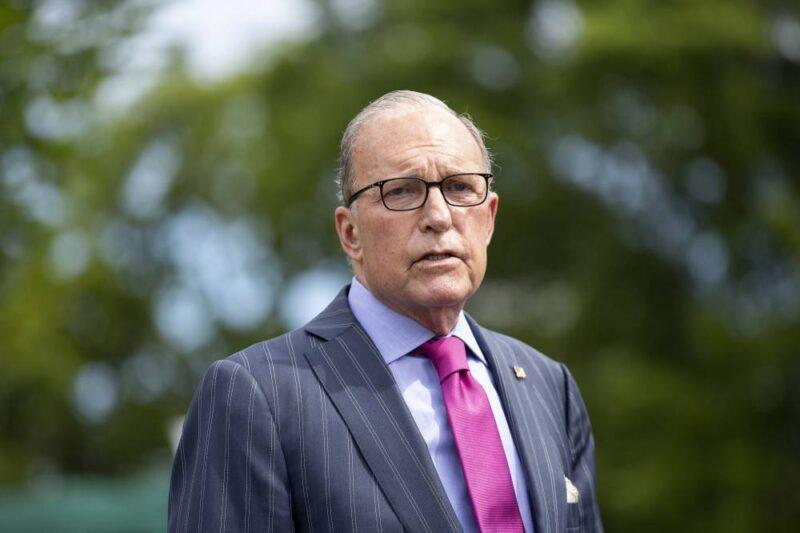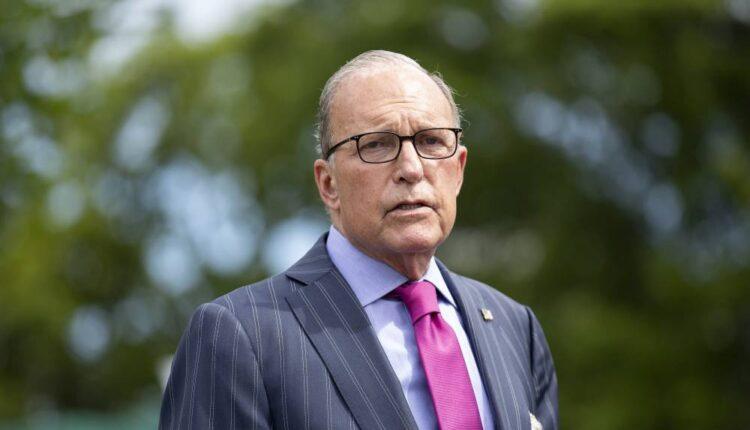
- The Trump administration doesn't want to extend the $600-a-week enhancement to unemployment benefits past July 31, according to Larry Kudlow, White House economic advisor.
- The White House and congressional Republicans want to provide a temporary cash bonus to those who find a job.
- Democrats want to extend the $600-a-week payments until next year or gradually reduce aid as the unemployment rate falls.
Larry Kudlow, director of the U.S. National Economic Council, speaks to members of the media outside the White House in Washington, D.C., U.S., on Monday, June 15, 2020.Photographer: Stefani Reynolds/CNP/Bloomberg via Getty Images
The Trump administration wants to end enhanced unemployment benefits and replace them with a different policy, according to a senior aide.
Federal coronavirus relief legislation enacted in March authorized jobless Americans to receive an extra $600 a week in unemployment benefits.
Those payments are scheduled to end after July 31, which may lead to a sharp decrease in cash flow for the roughly 30 million people currently receiving the benefit.
The unemployment rate in April and May was higher than at any time since the Great Depression.
The Trump administration, in line with many congressional Republicans, wants the $600 payments to end. The administration believes they provide a disincentive to find work or return to a job, according to Larry Kudlow, White House economic advisor.
More from Personal Finance
Trump vs. Biden: Americans split on who's better for their wallets
$600 unemployment benefits are 'life-saving' for this waiter
Additional stimulus legislation may be coming
VIDEO4:5604:56How to make money if you can't file for unemploymentInvest in You: Ready. Set. Grow.
The administration supports replacing the enhanced benefits, which are paid on top of traditional state-level benefits, with a cash bonus encouraging people to rejoin the workforce.
"The president is looking at a reform measure that would still provide some kind of bonus for returning to work, but it will not be as large and it will create an incentive to work," Kudlow, director of the National Economic Council, said Sunday on CNN.
While Kudlow didn't elaborate on the specific form of a return-to-work bonus, a few existing proposals hint at what such a policy may look like.
One from Sen. Rob Portman, R-Ohio, would replace the $600 weekly checks with temporary payments of $450 a week for those who return to work. Recipients would get the $450 plus their job's wages.
Another proposal, from Rep. Kevin Brady, R-Texas, would let workers who accept a job offer keep two weeks' worth of $600 enhanced unemployment benefits. Normally, if someone finds work, they would lose their unemployment benefits. The concept is comparable to a $1,200 "hiring bonus," Brady said.
VIDEO9:2909:29Can the US labor market bounce back from Covid-19?US Economy
However, in their current form, Portman's and Brady's policies each have a July 31 end date — the same expiration date as the $600-a-week benefits.
Democrats, on the other hand, want to extend enhanced unemployment benefits. They passed financial relief legislation in the House that would extend the $600 benefits until early next year.
Some Democrats have also proposed gradually reducing the aid by tying it to economic metrics like the state unemployment rate. (In other words, weekly benefits would decrease as a state's unemployment rate falls.)
Lawmakers will likely compromise and extend enhanced unemployment benefits in some form after July to avoid sending household income over a "cliff" for millions of Americans, according to Ernie Tedeschi, an economist at Evercore ISI.
That's because states generally replace between 30% and 50% of one's prior wages, Tedeschi said. (The $600-a-week enhancement aimed at fully replacing job wages for the average worker, who makes about $1,000 a week.)
"That [would be] a giant benefit cut," Tedeschi said.
Republican proposals leapfrog off an unexpected addition of 2.5 million jobs to the U.S. economy in May, versus an expected loss of around 7.5 million.
States are beginning to reopen their economies and many businesses that received Paycheck Protection Program loans have rehired workers to fulfill a condition of getting that federal aid.
"This is a turning point in the economy," Kudlow said. "Besides the great jobs numbers, you've got a lot of positive green-shoot indicators. We don't want to interrupt that [by extending unemployment benefits]."
However, critics say it's naive to think all Americans who lost their jobs since mid-March will be able to return to work by the end of July.
Twenty-one million people are still unemployed. There would need to be nine more months of job growth similar to those seen in May to roughly get back to employment levels in February.
If enhanced unemployment aid ends, potentially coinciding with businesses running out of loan money and households exhausting the one-time stimulus checks they received, Americans may cut spending significantly and cause another wave of job losses, according to economists.
Ioana Marinescu, an economics professor at the University of Pennsylvania, has a policy idea that blends Democratic and Republican ideals, offering a view at what a potential compromise could look like.
The proposal would pay $600 a week to workers who have lost their jobs for about four months, regardless of whether they remain unemployed or find new employment.
This "job losers' stimulus program" would keep unemployment benefits intact during a time of fragile economic recovery and also remove any perceived disincentive to work caused by enhanced unemployment benefits, according to the proposal.
VIDEO2:4802:48How unemployment benefits are calculatedInvest in You: Ready. Set. Grow.
Source: cnbc.com

